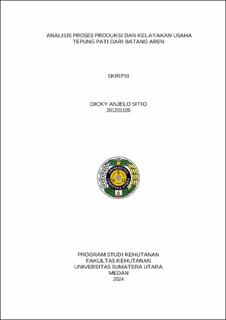Analisis Proses Produksi dan Kelayakan Usaha Tepung Pati dari Batang Aren
Analysis of Production Process and Business Feasibility of Starch Flour from Palm Stems

Date
2024Author
Sitio, Dicky Anjelo
Advisor(s)
Hakim, Luthfi
Jayusman
Metadata
Show full item recordAbstract
Arenga pinnata Merr has the potential to be cultivated as a food crop. This plant exhibits a wide altitudinal range, thriving at elevations ranging from 0 to 1,400 meters above sea level, and has a widespread distribution over nearly all regions of Indonesia. Every component of the palm plant can be employed for both food and non-food purposes, but the primary focus is on using the sap as a raw material for producing sugar, in both solid and liquid forms. The objective of this study is to assess the viability of establishing a dry palm starch production enterprise and serve as a guide for aspiring entrepreneurs interested in venturing into palm starch flour production. This study employs a blend of quantitative and qualitative methodologies. The findings indicated that the process of producing dried palm starch flour involved several sequential steps. These steps included the initial cleavage of palm stems, followed by grating, stirring the pith of the grated products, separating coarse fibers, filtering, precipitating, packing the wet starch, drying it, and finally packaging the dry starch flour. The facility has a manufacturing capacity of 5598.90 kg per day, with a wet starch yield of 73.35% and a dry starch yield of 44.45%. The annual production cost of dry starch flour is Rp.2,093,475,440, and the cost of producing each kilogram is Rp. 2,757.63. The Net Present Value of Rp. 2,596,510,262, a Benefit Cost Ratio of 5.60, an Internal Rate of Return of 81%, and a Pay Back Period were achieved in the first month at an interest rate of 14% per year.
Collections
- Undergraduate Theses [2147]
